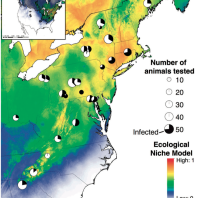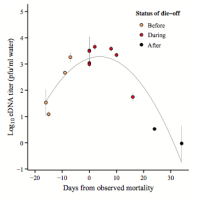A great deal of hard work went into both writing this book and making it open access. Jesse was involved in two chapters in particular:
Brunner, J. L., A. Storfer, M. J. Gray, and J. T. Hoverman. 2015. Ranavirus ecology and evolution: from epidemiology to extinction. Pages 71-104 in Gray, M. J., and V. G. Chinchar, editors. Ranaviruses: Lethal pathogens of ectothermic vertebrates. Springer, Seac, New Jersey.
Gray, M. J., J. L. Brunner, J. E. Earl, and E. Ariel. 2015. Design and Analysis of Ranavirus Studies: Surveillance and Assessing Risk. Pages 209-240 in Gray, M. J., and V. G. Chinchar, editors. Ranaviruses: Lethal pathogens of ectothermic vertebrates. Springer, Seac, New Jersey.
The whole book can be found here, for free! http://link.springer.com/book/10.1007/978-3-319-13755-1
 With the growing interest in ranaviruses, Matt Gray and the GRC are offering an online class on ranavirus biology Feb-April 2016. You can find more information and register here. I will be teaching several days of the class, so it will be amazing for sure…
With the growing interest in ranaviruses, Matt Gray and the GRC are offering an online class on ranavirus biology Feb-April 2016. You can find more information and register here. I will be teaching several days of the class, so it will be amazing for sure…

